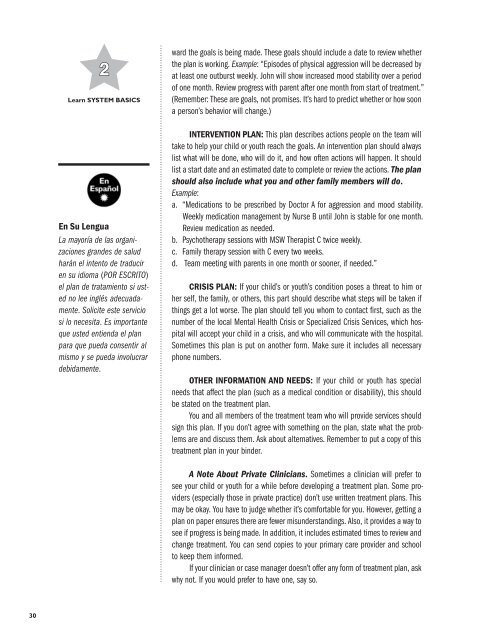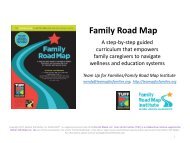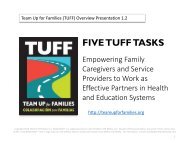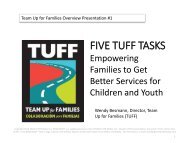Family Road Map Guide
Create successful ePaper yourself
Turn your PDF publications into a flip-book with our unique Google optimized e-Paper software.
2<br />
Learn SYSTEM BASICS<br />
ward the goals is being made. These goals should include a date to review whether<br />
the plan is working. Example: “Episodes of physical aggression will be decreased by<br />
at least one outburst weekly. John will show increased mood stability over a period<br />
of one month. Review progress with parent after one month from start of treatment.”<br />
(Remember: These are goals, not promises. It’s hard to predict whether or how soon<br />
a person’s behavior will change.)<br />
En Su Lengua<br />
La mayoría de las organizaciones<br />
grandes de salud<br />
harán el intento de traducir<br />
en su idioma (POR ESCRITO)<br />
el plan de tratamiento si usted<br />
no lee inglés adecuadamente.<br />
Solicite este servicio<br />
si lo necesita. Es importante<br />
que usted entienda el plan<br />
para que pueda consentir al<br />
mismo y se pueda involucrar<br />
debidamente.<br />
INTERVENTION PLAN: This plan describes actions people on the team will<br />
take to help your child or youth reach the goals. An intervention plan should always<br />
list what will be done, who will do it, and how often actions will happen. It should<br />
list a start date and an estimated date to complete or review the actions. The plan<br />
should also include what you and other family members will do.<br />
Example:<br />
a. “Medications to be prescribed by Doctor A for aggression and mood stability.<br />
Weekly medication management by Nurse B until John is stable for one month.<br />
Review medication as needed.<br />
b. Psychotherapy sessions with MSW Therapist C twice weekly.<br />
c. <strong>Family</strong> therapy session with C every two weeks.<br />
d. Team meeting with parents in one month or sooner, if needed.”<br />
CRISIS PLAN: If your child’s or youth’s condition poses a threat to him or<br />
her self, the family, or others, this part should describe what steps will be taken if<br />
things get a lot worse. The plan should tell you whom to contact first, such as the<br />
number of the local Mental Health Crisis or Specialized Crisis Services, which hospital<br />
will accept your child in a crisis, and who will communicate with the hospital.<br />
Sometimes this plan is put on another form. Make sure it includes all necessary<br />
phone numbers.<br />
OTHER INFORMATION AND NEEDS: If your child or youth has special<br />
needs that affect the plan (such as a medical condition or disability), this should<br />
be stated on the treatment plan.<br />
You and all members of the treatment team who will provide services should<br />
sign this plan. If you don’t agree with something on the plan, state what the problems<br />
are and discuss them. Ask about alternatives. Remember to put a copy of this<br />
treatment plan in your binder.<br />
A Note About Private Clinicians. Sometimes a clinician will prefer to<br />
see your child or youth for a while before developing a treatment plan. Some providers<br />
(especially those in private practice) don’t use written treatment plans. This<br />
may be okay. You have to judge whether it’s comfortable for you. However, getting a<br />
plan on paper ensures there are fewer misunderstandings. Also, it provides a way to<br />
see if progress is being made. In addition, it includes estimated times to review and<br />
change treatment. You can send copies to your primary care provider and school<br />
to keep them informed.<br />
If your clinician or case manager doesn’t offer any form of treatment plan, ask<br />
why not. If you would prefer to have one, say so.<br />
30














